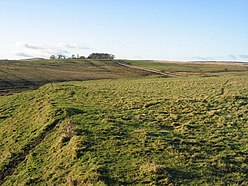 | |
|
| |
| Alternative name(s) | Brocolitia, Procolita, or Brocolita |
| Location | |
| Coordinates | 55°02′10″N 2°13′23″W / 55.036°N 2.223°W |
| County | Northumberland |
| Country | England |
| Reference | |
| UK-OSNG reference | NY858712 |
Carrawburgh is a settlement in Northumberland. In Roman times, it was the site of a 3½ acre (1.5 ha) auxiliary fort on Hadrian's Wall called Brocolitia, Procolita, or Brocolita[1][2] This name is probably based on the Celtic name for the place, and one possible translation put forward is 'badger holes'. The fort there was the Wall's northernmost point, and just over a mile west of the nearest milecastle, Milecastle 30. It either used the Wall (narrow gauge on a broad base at this point) itself as its northern rampart, or was built parallel to it but detached. It certainly postdates both the Wall and the vallum (which it is built across).
Only the fort's earthworks are now visible, the Wall at this point and the fort's north ramparts having been demolished for the construction of General Wade's early 18th century military road (now the B6318). The late nineteenth century archaeologist John Clayton carried out a partial excavation of the site, revealing a military bath-house outside the fort's west gate (in 1873) and the fort's south-west corner-tower (in 1876).
The Roman Inscriptions of Britain lists 48 inscriptions for the site. They show its garrisoning units to have been as follows:
- RIB 1550 - Hadrianic? - First Cohort of Aquitani
- RIB 1563b - AD122-138 - First Cohort of Tungri
- End 2nd century - Cohors I Cugernorum
- RIB 1544,[3] RIB 1553, and Notitia Dignitarum - AD213-222? and AD237 respectively[4] - First Cohort of Batavians
The First Cohort of Frisiavones are also attested at Brocolitia at some stage, as shown by an inscription on an altar stone, which tells us that Optio Maus had repaid a vow to the goddess Coventina. (This unit is also recorded as present at Ardotalia.[5]) Whether this altar was the repayment of the vow is unknown.
Temple of Mithras[]

The Mithraeum
In the small vicus on the low-lying marshy ground outside the fort's south-west corner have been found three religious sites, all connected with a small tributary stream of Meggie's Dene Burn, which runs three miles from Carrawburgh to empty into the River South Tyne near Newbrough's fort on the Stanegate. Nearest to the fort was an early 3rd century Mithraeum, of which remains can be seen onsite, and a reconstruction at Newcastle University's Museum of Antiquities. It was discovered in 1949. Behind it was a nymphaeum (found in 1957 and dug in 1960). The third site was "Coventina's Well", a centre for worship of the Romano-British goddess Coventina found in Clayton's 1876 dig, and from which the stream sprung. No remains of the nymphaeum or Well can now be seen onsite.
References[]
- ↑ The name "Procolita" is found in the 5th century document Notitia Dignitatum, and "Brocoliti" in the 7th century Ravenna Cosmography. In both instances it appears between the entries for Chesters (Cilurnum/Celunnum) and Housesteads(Borcovicium/Velurtion).
- ↑ Roman Britain - Brocolitia
- ↑ Altar to Mithras
- ↑ The latter is one of the few pieces of evidence for the governor Tuccianus, under the emperor Maximinus
- ↑ Roman Britain - Ardotalia
External links[]
| Wikimedia Commons has media related to Carrawburgh. |
- BROCOLITIA at www.Roman-Britain.org
- BROCOLITIA FORT on the line of Hadrian's Wall as it exists today
| |||||||||||||||||||
The original article can be found at Carrawburgh and the edit history here.

